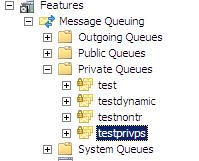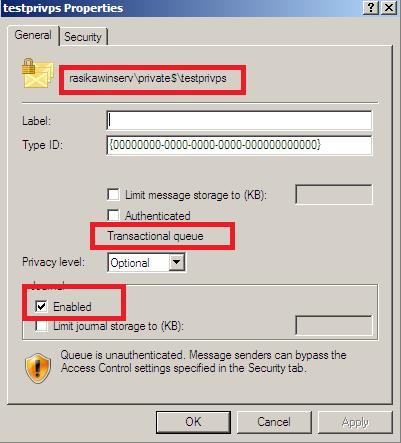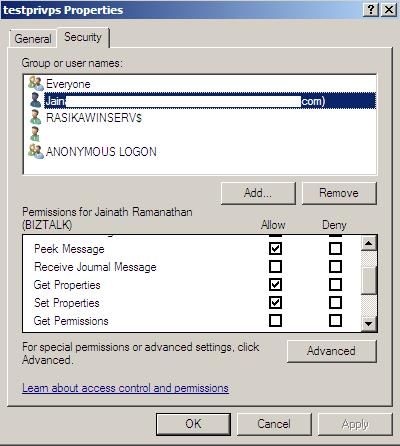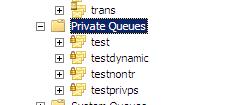Powershell Scripts to Manage MSMQ
We can manage MSMQ using Powershell. Powershell scripts help you automate the management of MSMQ and provide a quick way to create queues, manage users and permissions, get queue information etc. We have seen several blogs on internet, but here we will try to provide a collective information related to MSMQ management.
In this blog we will discuss how to implement System.Messaging.MessageQueue to implement various MSMQ functionalities. We will cover following topics:
- Creating Queues
Private/Public
Transactional/NonTransactional
Journal Queues - Adding user to the private queues and setting permissions
Full Permission
Restricted Permission - Deleting the Queues
I am uploading a powershell script which will implement all the mentioned functionalities. I will discuss the implementation of each of these functionalities today.
To run any powershell script, please run the following command: set-executionpolicy unrestricted
In order to create MSMQ, we need to implement the System.Messaging.MessageQueue.
[Reflection.Assembly]::LoadWithPArtialName("System.Messaging")
$msmq = [System.Messaging.MessageQueue]
Creating MSMQ Queues
Feed the input: Enter Queuename, Y/N - Private, Y/N - Transactional, Y/N - Journal (separate with comma)
Get each value in a separate variable and then on the basis of whether the queue is private or not, form the Queue Path:
$name = $parameters[0]
$isPrivate = $parameters[1]
$isTransactional = $parameters[2]
$isJournal = $parameters[3]
Before creating the Queue, we should check if the queue already exists:
If ($msmq::Exists($qname))
{
Echo ($name + " queue already exists")
}
For example, I have a private queue “testprivps” already created, then the script should return that the queue is already existing.
If the queue does not exists, then proceed with creating the queues. On the basis of whether the queue is private/public, create the path.
If ($isPrivate -ieq "Y")
{
$qname = ".\private$\" + $name
If Public Queue: $qname = ".\" + $name
To declare the queue as Transactional/Non Transactional, following line of code has to be written:
If ($isTransactional -ieq "Y")
{
$qObject = $msmq::Create($qname,1) (1 indicates Transactional Queue)
}
Else
{
$qObject = $msmq::Create($qname)
}
To declare the queue as Journal, following line of code has to be written:
If ($isJournal -ieq "Y")
{
$qObject.UseJournalQueue = $TRUE
}
For e.g. if I create a private transactional queue, with name: testprivps and journaling enabled, give the following parameters as input:
The reason why the Queue got created with a name which is not case sensitive is a fact that for MSMQ, TestPrivPS and testprivps is the same thing. Refer to the following article for more details: https://msdn.microsoft.com/en-us/library/windows/desktop/ms706083(v=vs.85).aspx
Adding user to the private queues and setting permissions
Permissions can be granted at 2 levels:
Full Permission
Restricted Permission
Following statement can be used to get the input about the user name and the permission level:
$Control = (Read-Host "Enter Username, Full Control <Y/N> (separate with comma)").split (',') | % {$_.trim ()}
System.Messaging.MessageQueueAccessRights is used to set the permission type, whereas System.Messaging.AccessControlEntryType is used to define if the permission is given or denied.
For full control, we need to write the following line of code:
$qObject.SetPermissions($user, [System.Messaging.MessageQueueAccessRights]::FullControl, [System.Messaging.AccessControlEntryType]::Allow)
To set the permissions that are granted to the supplied user account or group, we need to use the following keys corresponding to the permission type:
Delete (Delete the specified queue) - DeleteQueue
Receive (Receive a message from the specified queue) - ReceiveMessage
Peek (Peek a message from the specified queue) - PeekMessage
JournalReceive (Receive a message from the specified queue’s journal queue) - ReceiveJournalMessage
GetProperties (Get the properties of the specified queue) - GetQueueProperties
SetProperties (Set the properties of the specified queue) - SetQueueProperties
GetPermissions (Get the permissions of the specified queue) - GetQueuePermissions
SetPermissions (Set the permissions of the specified queue) - ChangeQueuePermissions
TakeOwnership (Assign the specified queue to oneself) - TakeQueueOwnership
Send (send a message to the specified queue) - WriteMessage
For e.g.
$qObject.SetPermissions($user, [System.Messaging.MessageQueueAccessRights]::DeleteQueue, [System.Messaging.AccessControlEntryType]::Set)
$qObject.SetPermissions($user, [System.Messaging.MessageQueueAccessRights]::ReceiveMessage, [System.Messaging.AccessControlEntryType]::Allow)
$qObject.SetPermissions($user, [System.Messaging.MessageQueueAccessRights]::PeekMessage, [System.Messaging.AccessControlEntryType]::Allow)
For Restricted Permissions :
Delete the Queues
To delete the queue, we need to determine if the queue that we want to delete is a private or a public queue. The Queue deletion will depend on the queue path.
On the basis of whether the queue is private or public, we will create the path accordingly and delete the queue.
[System.Messaging.MessageQueue]::Delete($qname)
You can use the following piece of code for deleting a private queue:
$QueueName = Read-Host 'Enter the queue name you want to delete'
$qname = ".\private$\" + $QueueName
if ($msmq::Exists($qname))
{
[System.Messaging.MessageQueue]::Delete($qname)
}
For example:
Please note that in this script we have not used any code to handle the errors. In the upcoming blogs, we will discuss the implementation of managing messages in the MSMQ Queues. Also, if we are using Powershell Extensions or Windows Server 2012, then we can use Powershell commandlets to manage the MSMQ Queues. We will also discuss the use of these cmndlets in some time.
Hope this helps.. !!
Written By
Rasika Chaudhary
Reviewed By
Gautam Mansinghka
Microsoft GTSC
MSMQManagePowershellScript.txt
Comments
Anonymous
April 04, 2014
Any suggestions on how to get a private queue count using these methods?Anonymous
April 13, 2014
Hi,Great post!Is there a way to modify this script to delete all private queues?ThanksAnonymous
May 29, 2014
Thanks, this helped me work around a weird GUI bug. MSMQ was installed but didn't appear in Computer Management interface. I followed your guide to create queues with PowerShell. After that, MSMQ appeared!elder.io/creating-msmq-queues-with-powershellAnonymous
May 29, 2014
Clean and crystal clear. Thanks for the detailed post.Anonymous
July 23, 2014
I need to set up a monitoring system for the private queue count: if it exceeds n, then do something. How can I get MessageCount from get-msmqqueue? Or is there a better cmdlet?Anonymous
July 28, 2014
How can I purgue queue in remote server?Anonymous
July 31, 2014
Is there any way to modify the permissions for existing queuesAnonymous
August 21, 2014
Hi All,I will look further into all your queries and try to come up with a compile blog real soon.Anonymous
December 23, 2015
In your screenshot, the label value is not set.. Is there a way to set it using powershell script ?Anonymous
November 17, 2017
$qObject = $msmq::Create($qname) how do I set $qobject to some existing queue without creating a new one so I can set permission on an existing queue without creating a new one?











